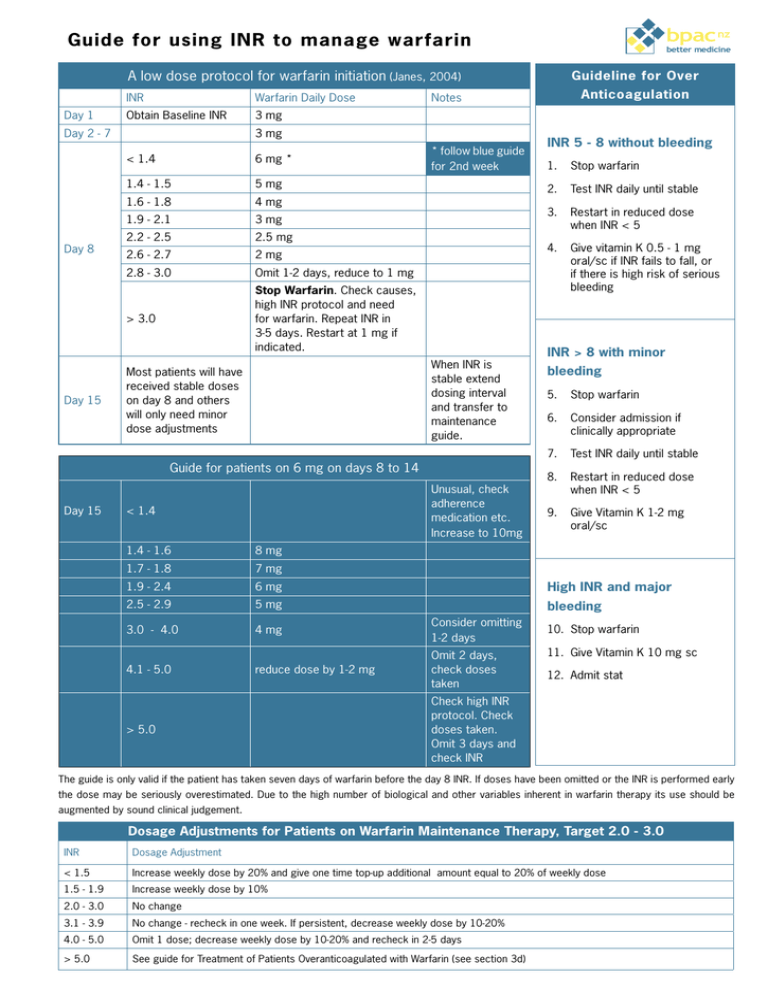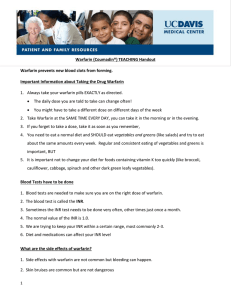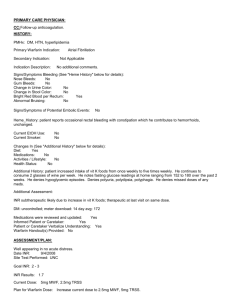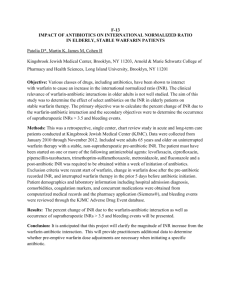Warfarin INR Management Guide | Dosage & Treatment
advertisement

bpac nz Guide for using INR to manage warfarin better medicine A low dose protocol for warfarin initiation (Janes, 2004) Day 1 INR Warfarin Daily Dose Obtain Baseline INR 3 mg Day 2 - 7 Day 8 Day 15 6 mg * 1.4 - 1.5 5 mg 1.6 - 1.8 4 mg 1.9 - 2.1 3 mg 2.2 - 2.5 2.5 mg 2.6 - 2.7 2 mg 2.8 - 3.0 Omit 1-2 days, reduce to 1 mg > 3.0 Stop Warfarin. Check causes, high INR protocol and need for warfarin. Repeat INR in 3-5 days. Restart at 1 mg if indicated. * follow blue guide for 2nd week When INR is stable extend dosing interval and transfer to maintenance guide. Most patients will have received stable doses on day 8 and others will only need minor dose adjustments Guide for patients on 6 mg on days 8 to 14 Day 15 Unusual, check adherence medication etc. Increase to 10mg < 1.4 1.4 - 1.6 8 mg 1.7 - 1.8 7 mg 1.9 - 2.4 6 mg 2.5 - 2.9 5 mg INR 5 - 8 without bleeding 1. Stop warfarin 2. Test INR daily until stable 3. Restart in reduced dose when INR < 5 4. Give vitamin K 0.5 - 1 mg oral/sc if INR fails to fall, or if there is high risk of serious bleeding INR > 8 with minor bleeding 5. Stop warfarin 6. Consider admission if clinically appropriate 7. Test INR daily until stable 8. Restart in reduced dose when INR < 5 9. Give Vitamin K 1-2 mg oral/sc High INR and major bleeding 3.0 - 4.0 4 mg Consider omitting 1-2 days 4.1 - 5.0 reduce dose by 1-2 mg Omit 2 days, check doses taken > 5.0 Anticoagulation Notes 3 mg < 1.4 Guideline for Over 10. Stop warfarin 11. Give Vitamin K 10 mg sc 12. Admit stat Check high INR protocol. Check doses taken. Omit 3 days and check INR The guide is only valid if the patient has taken seven days of warfarin before the day 8 INR. If doses have been omitted or the INR is performed early the dose may be seriously overestimated. Due to the high number of biological and other variables inherent in warfarin therapy its use should be augmented by sound clinical judgement. Dosage Adjustments for Patients on Warfarin Maintenance Therapy, Target 2.0 - 3.0 INR Dosage Adjustment < 1.5 Increase weekly dose by 20% and give one time top-up additional amount equal to 20% of weekly dose 1.5 - 1.9 Increase weekly dose by 10% 2.0 - 3.0 No change 3.1 - 3.9 No change - recheck in one week. If persistent, decrease weekly dose by 10-20% 4.0 - 5.0 Omit 1 dose; decrease weekly dose by 10-20% and recheck in 2-5 days > 5.0 See guide for Treatment of Patients Overanticoagulated with Warfarin (see section 3d) Treatment Guide for managing Warfarin bpac nz better medicine INR testing frequency • The INR is generally considered stable when two or more consecutive tests, performed at least 24 hours apart are within the target range • Some fluctuation of the INR within the target range is to be expected and adjustment of the dose is not required but wide variations within the range over a few days may be more significant. For patients initiated with low-dose protocol (warfarin initial For patients initiated with higher doses: dose 2 -3 mg): Initially When INR < 4: Weekly Until stable for When INR > 4: Every 2-3 2 consecutive days tests Initially Daily for at least Until stable for 2 Then: five days consecutive tests every 3 - 5 days Until stable for 2 consecutive tests Until stable for Then: Fortnightly 2 consecutive Then: weekly Then: fortnightly consecutive tests tests Until stable for 2 - 3 consecutive tests Most patients can be extended to 4-6 weekly Maintenance: testing however a minority may require more Until stable for 2 - 3 Maintenance: Most patients can be extended to 4-6 weekly testing however a minority may require more frequent testing frequent testing Patient education needs to cover at least the following key points: Need for patient to regularly remind their doctor, pharmacist, Specimen Collection: • light blue top tube dentist or other health professional they are receiving warfarin Requirement for regular blood tests Adherence to dosage changes following blood test results Importance of avoiding other medications (including herbal medicines and supplements) except following discussion with clinician, pharmacist or other healthcare provider • The tube must be filled completely • View the patient handbook • Ask questions specific to warfarin control, for example: - Adherence to the dosing regimen - Any changes in diet - Any medications the patients may have stopped or started Significance of illness, such as diarrhoea, infection or fever on warfarin use Blood specimens should be collected into a - Signs of bleeding Ability to recognise the signs of possible bleeding Bleeding is the most serious potential side effect of warfarin. If patients experience any of the following symptoms, they must call their doctor immediately: Red or dark brown urine Excessive menstrual bleeding Unusual pain, swelling or bruising Red or black stool Prolonged bleeding from gums or nose Dark, purplish or mottled fingers or toes Unusual weakness, Severe headache Dizziness, trouble breathing or chest pain Vomiting or coughing up blood INR Testing | 21 Appendix 3 Drugs which potentiate the action of warfarin Drugs which potentiate the action of warfarin Antibiotics Anti-inflammatory Cardiac Gastrointestinal Psychiatric Other Cotrimoxazole NSAIDs Amiodarone Omeprazole Paroxetine Tramadol Erythromycin COX II inhibitors Propranolol Cimetidine Fluoxetine Phenytoin Norfloxacin Sulfinpyrazone Clofibrate Citalopram Tamoxifen Roxsithromycin Salicylates Cephalosporin Paracetamol Ciprofloxacin Azithromycin Fluconazole Miconazole (including gel) Metronidazole Isoniazid INR Testing | 23 Appendix 4. Adding an alert for patients on warfarin To set up an alert to use for patients on warfarin An alert which appears whenever the clinical records of a patient on 1. From the menu select: Setup > Patient Register > Alert warfarin are accessed. 2. Put a code, perhaps “warf”, in the appropriate box and put “On Warfarin” in the For use with MedTech. description box. 3. Click OK, your alert is now set up for use. To use the warfarin alert for a particular patient 1. When the patient’s clinical records are open 2. From the menu select: Module > Alerts 3. Click on the box in the window that opens to assign a new alert to the patient 4. In the code box enter “warf” or whatever code you used. 5. In the text box underneath put details of: • Condition for which patient is on warfarin • Date therapy started • Planned duration of treatment • Target INR Note: you cannot use the enter key when you are in this text box. 6. Tick the box labelled Auto Prompt Alert 7. Click OK, your alert should now open whenever the patient’s clinical records are accessed. 24 | INR Testing


